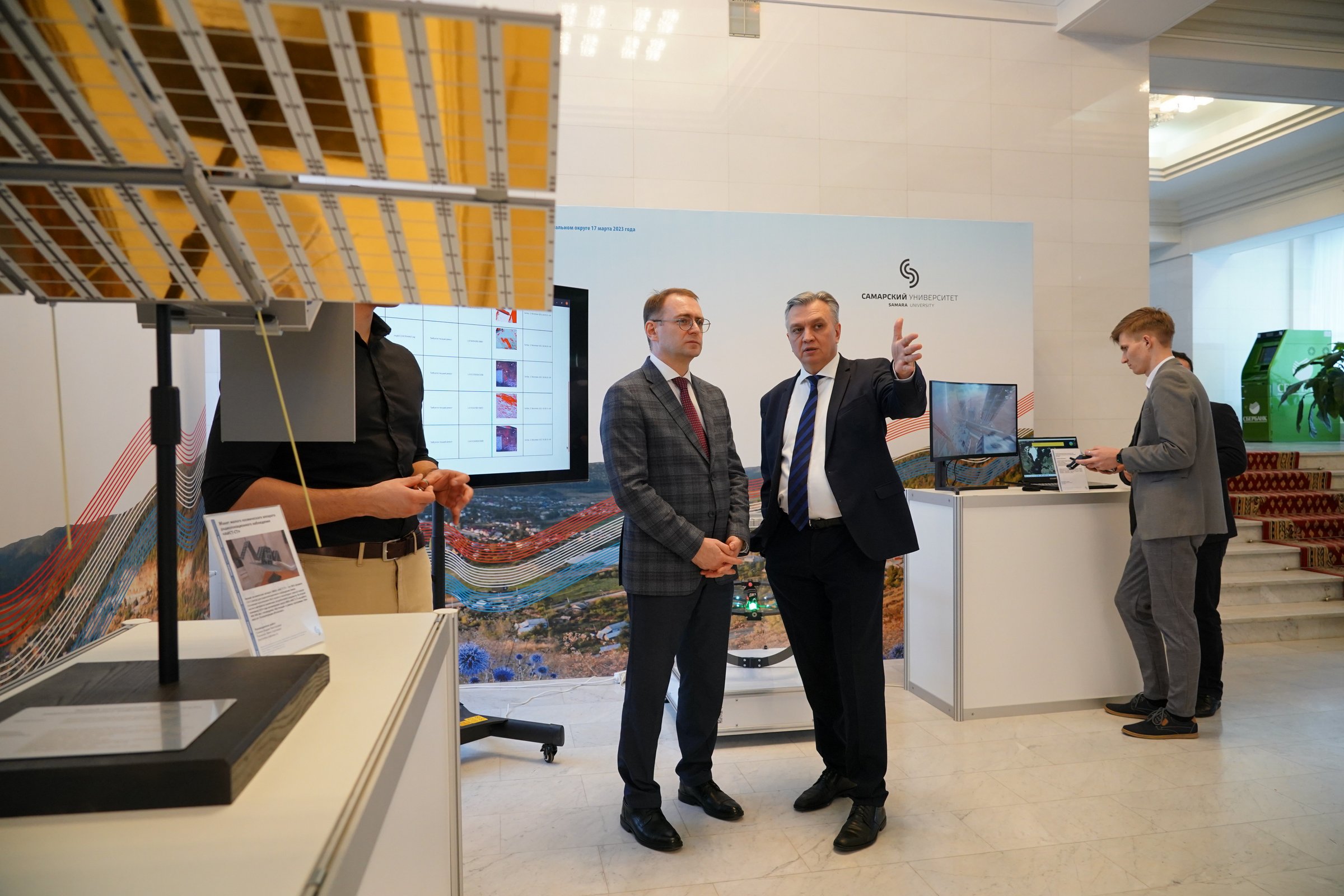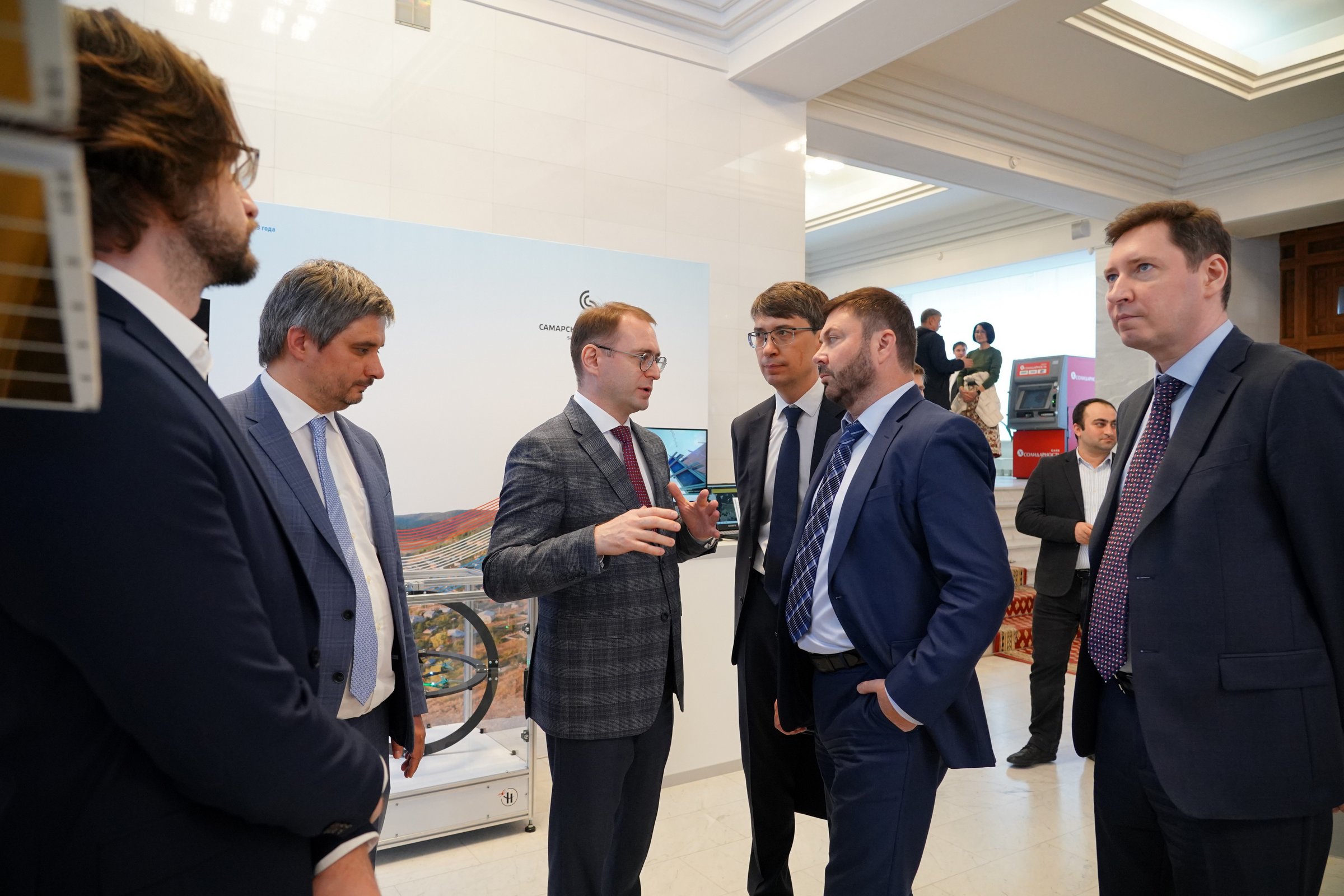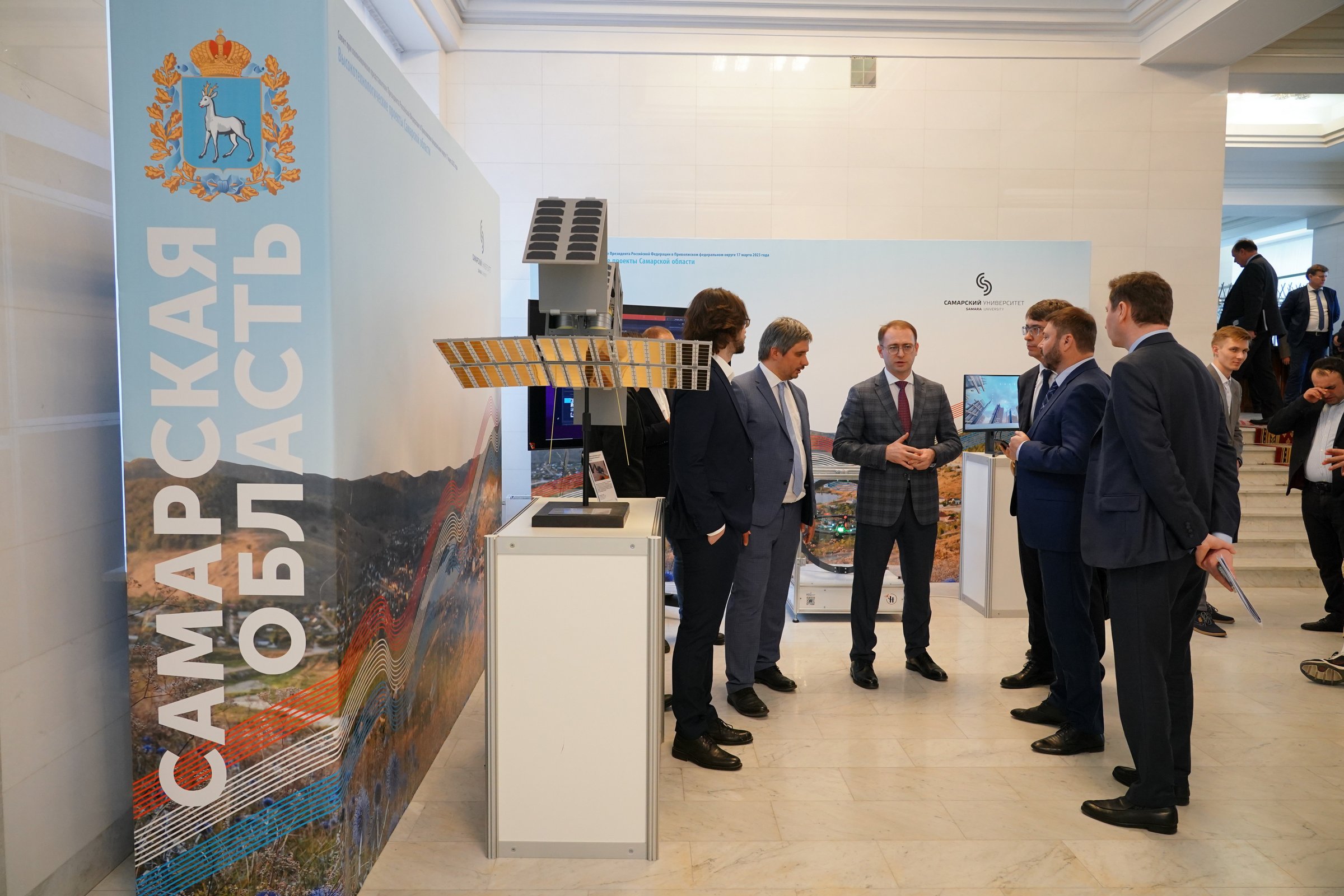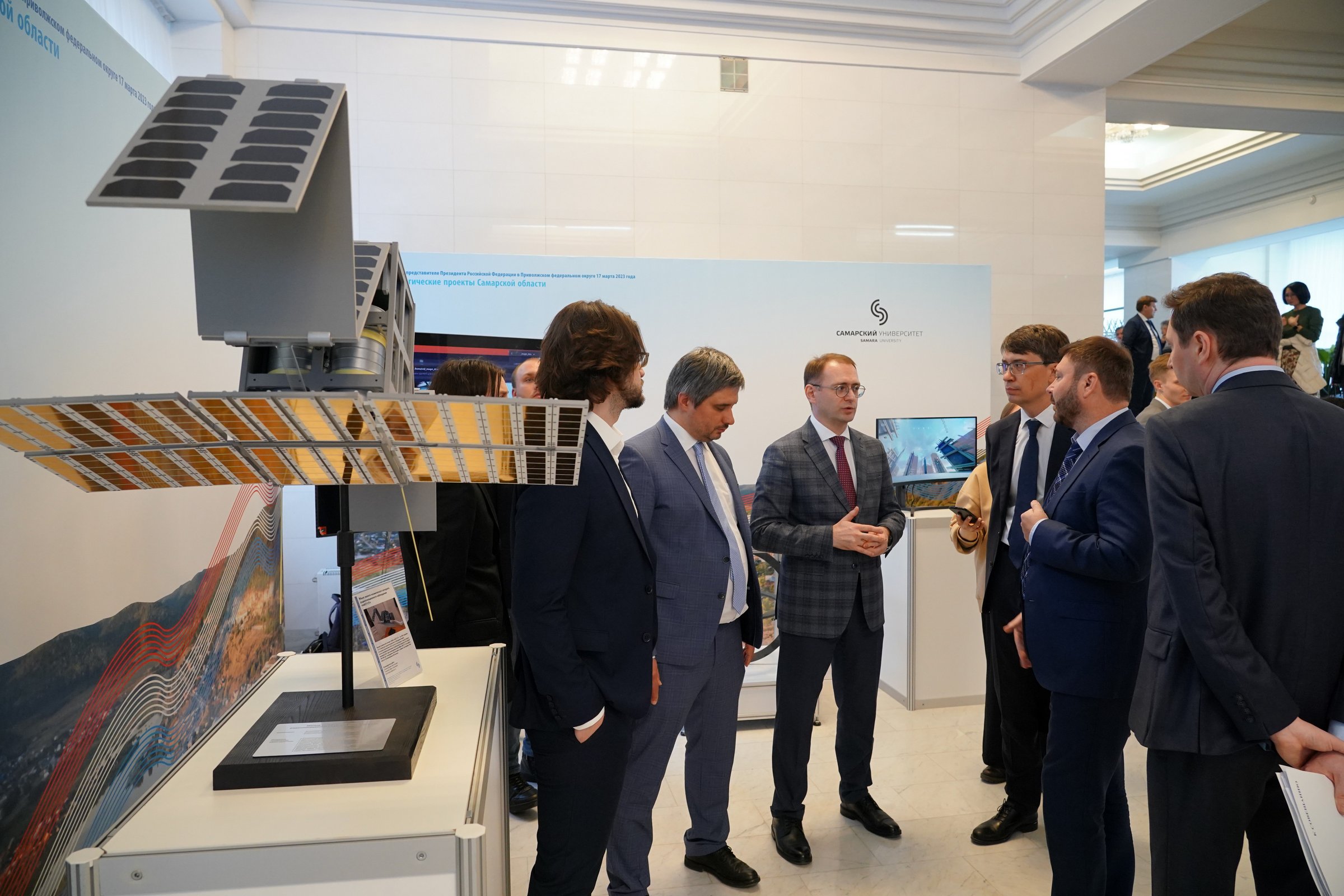On Friday, March 17, the Privolzhsky Federal District Council was held in Samara under the Plenipotentiary Representative of the President of the Russian Federation in the Privolzhsky Federal District Igor Komarov. The meeting was attended by the Governor of the Samara region Dmitry Azarov, General Director of ANO Agency for Strategic Initiatives Svetlana Chupsheva, heads of specialized federal ministries, heads of Privolzhsky Federal District regions, representatives of the business community.
In the building of the Samara region government, where the meeting was held, leading universities and companies of the region presented their advanced developments and innovative products.
All participants of the meeting could get acquainted with the high-tech projects of Samara developers.
The main sample of the exhibition, attracting the attention of guests, was the cargo unmanned aviation system – a unique platform with several modifications to perform a variety of tasks: from delivering cargo to extinguishing fires.
Significant preparatory work has already been done in the region. Some new UAD (unmanned air drone) models are already undergoing experimental testing, and their mass production is being prepared in the future. Leading universities, which already have relevant developments, as well as the world-class scientific and educational centre "Engineering of the Future" will be involved in this work.
"Samara unmanned air drones will be used in all sectors of the economy, including agriculture and transport, as well as for solving a wide range of tasks, Governor Dmitry Azarov noted. – I am sure that we will move at a faster pace, and the Samara region, as it should be the space capital of the country, in the coming months will please the Motherland with unmanned air drones of a new type."
Recall that one of the key issues in the implementation of the project, which is strategically important both for the Samara Region and for the whole country, is the establishment in the region territory of an experimental legal regime in operation of unmanned aviation systems. This issue was discussed by the head of the Samara region during a working meeting with the Minister of Economic Development of Russia Maxim Reshetnikov. Then the region submitted the corresponding application.
"What exactly the Samara region is ahead – this is a project on unmanned air drones. This is a very topical theme now – we protect both our sky and our industrial enterprises, and critical infrastructure facilities. We need to develop this industry," the head of the Republic of Mordovia Artem Zdunov said, evaluating the exposition and UAD model presented.
"Our task in Samara is not only to form a production site, to establish the production of hundreds and thousands of different unmanned air drones, but also to work out typical business models, because the time has come when such drones should appear," the General Director of "The Transport of the Future" company Yury Kozarenko said.
At that the company head noted that when mass production of UADs is launched, the training of pilots and the development of special training programs will become an important task.
The unique development of scientists from the Samara National Research University. Vladimir Kirillov, an engineer at the Centre for Unmanned Systems under Samara University, said about the possibilities of the training complex for the training of specialists in unmanned aviation that was also presented at the exhibition.
"The complex is designed to equip educational classes, flight ranges, vocational training organizations, higher education institutions and other educational establishments that train external pilots of unmanned aviation systems. Already, up to 80 people are trained a year using this simulator," he said.
The University also presented another development of its own – a small spacecraft for radar observation of the Earth "AIST-ST". It is important that senior students and graduate students are involved in the project work. The equipment allows you to take pictures of the earth's surface with any level of illumination and in any weather conditions, which is especially important at high overcast.
"This spacecraft is built on modular modern technologies and is also designed for the current task of Earth remote sensing with radar. At the moment, in Russia and in the world, there are much fewer radar devices than optical surveillance devices. Its launch into the Earth's orbit is scheduled for 2024 as part of the Universat program," an assistant at the Department of Space Engineering at Samara University Maxim Ivanushkin said.
Institute of Artificial Intelligence under the Samara University presented at the exhibition a software package for intelligent monitoring, which was developed in the interests of the industrial partner of the University, Russian Railways, and was funded, among other things, from the Innovation Fund of the Samara Region. The project involves the collection and analysis of data from unmanned air drones about the condition of buildings and structures.
"The most interesting part of the project in terms of its implementation was the development of an artificial intelligence system based on neural networks. We have applied an innovative scheme for training neural networks using a synthetic data set. Using a special program, we simulated various types of defects in buildings and structures, and trained our neural network on these images, and then tested it on real objects – it turned out that everything works fine," a lead software programmer at the Institute of Artificial Intelligence under Samara University Evgeny Minaev said.
Samara State Technical University presented a training and laboratory complex for practicing the skills of performing operations for pig launchers and receivers using VR technologies for training students and employees of specialized enterprises.
Specialists of the Institute of Innovative Development of SamSMU demonstrated the work of Virtual Clinic simulator created by them – a comprehensive innovative solution for digitalization of the educational process.
AntenMed Samara company presented the model of clean room complex to use in sets of operating theatres and resuscitation units that allow to minimize the risk of nosocomial infections.
It is worth noting that at the moment the company jointly with SamSMU is developing a Smart Operating Room project, which will provide a comfortable operation environment for medical personnel, integrate medical equipment and engineering systems with the function of centralized monitoring and management into a single information space.
A lot of developments in IT technologies were presented. Representatives of the AR SOFT company told and showed the exhibition guests the software possibilities for 3D modeling of engineering networks based on AR technologies. The system allows you to perform modeling of engineering networks in augmented and mixed reality glasses directly being at the objects of the proposed reconstruction or construction. At the moment, the software includes three areas of engineering networks: ventilation and piping, cable support systems, and metal structures.
Zhigulevskaya Dolina technopark had its stand at the exhibition. In 2022, the technopark was among the top three technoparks in the Russian Federation according to the rating of the Association of Clusters, Technoparks and SEZs (special economic zones) of Russia. In addition, Zhigulevskaya Dolina is the operator of the Skolkovo Foundation in the Samara Region, according to the results of 2022 the technopark was recognized as the best regional operator of Skolkovo.
The number of Zhigdolina residents is more than 290. The total area of the technopark facilities is more than 65 thousand square meters. The project is aimed at creating a favorable environment for innovative development and modernization of the Samara region economy, creating new jobs and diversification the Togliatti economy, integrating science, education, financial institutions, enterprises and entrepreneurs. The main task of the technopark is to provide support to projects and companies working in innovation and high technology at all stages: from the idea to the market penetration of the final product.
The model of the Volga Bridge and the Tolyatti Bypass highway – the largest project in Russia, which is implementing on public-private partnership principles, took a special place at the exhibition. The project is of great importance for building new logistics chains. The world's longest economic corridor with a huge potential for interstate and interregional cooperation will increase the investment potential of the Samara region, open up new opportunities for the creation of industries and jobs in the region for the government residents.
Also, the exhibition guests could get acquainted with the capabilities of self-propelled agricultural machinery, product quality assurance system, digital solutions for smart roads and other high-tech developments of Samara companies.
The Source: volga.news
 RU
RU  EN
EN  CN
CN  ES
ES 



